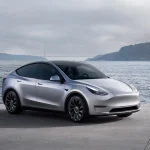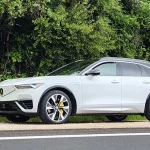
2017 Ford Fusion Energi: low electric range, no public charging frustrating2017 Ford Fusion Energi: low electric range, no public charging frustrating
Electric-car charging infrastructure in the United States is getting better, but still has a very long way to go.
While anyone that’s given even a passing glance to plug-in vehicles would likely tell you the same thing, I experienced the impact of a charging-free society first-hand while driving a Ford Fusion Energi.
The plug-in hybrid Fusion takes the best parts of a Chevrolet Volt or Toyota Prius Prime—the ability to cover a useful distance on battery power alone—and inserts it into a vehicle with a handsome, much less polarizing design.
DON’T MISS: 2017 Ford Fusion Hybrid, Energi: Software Tweaks For Drivability Improvements
As a mid-size sedan, it promises more cabin space and better driving dynamics. It’s a winning formula, but only if you have a reliable way to recharge the battery.
I didn’t.
During five days behind the wheel, I covered more than 210 miles, but I was only able to recharge the battery overnight, using the 120-volt plug on the side of my garage.
2017 Ford Fusion Energi
In other words, my Fusion Energi never saw a 240-volt Level 2 charging station.
In the car’s defense, though, you don’t really need one. In fact, I’d go so far as saying that if I purchased a Fusion Energi, I wouldn’t bother installing one.
Recharging isn’t a lengthy process, even with a normal house plug—the Fusion took just over 6 hours to acquire 19 miles of electric range.
READ THIS: 2017 Ford Fusion Energi electric range rises to 22 miles
Those numbers clash with the EPA range rating, which comes in at 22 miles—a number I never saw, despite leaving the car plugged in all night. Ignoring the discrepancy, there’s just enough juice for my needs.
My home in southern Oakland County, 1.5 miles from the Detroit border, is just over 19 miles from my office in Auburn Hills. With some intelligent driving, I could complete one leg of the journey with anywhere from 2 to 4 miles of charge to spare.
But once I was at the office, I was screwed, because there was no easy way to recharge the car.
2016 Ford Fusion Energi
I downloaded the PlugShare app, thinking it’d help me find a charging location, but all it really did was frustrate me. According to the app, there were six stations within a mile, but the nearest one was three-quarters of a mile away.
Walking that distance might be fine in southern California, but metro Detroit’s weather and unfriendly attitude towards pedestrians make it next to impossible.
It left me wondering why, in 2017, this is a thing. Why aren’t there at least a pair of 220-volt chargers in every corporate parking lot? Why isn’t there one at the McDonald’s up the street, or the Starbucks down the street?
CHECK OUT: 2017 Ford Fusion Hybrid and Energi: how engineers increased fuel efficiency
Why am I at an office mere minutes from the site, of Chevrolet Bolt EV production and I can’t recharge a piddly 7.6-kilowatt-hour lithium-ion battery for a couple of hours?
This may be more of a problem for the all-electric Bolt EV. For the plug-in hybrid Fusion, it’s merely an inconvenience: run out of batteries and you’re effectively driving a Fusion Hybrid with less trunk space—the two cars are otherwise remarkably similar.
But is it a big enough issue to dissuade customers from getting behind the wheel? The answer feels like a “yes.”
Battery pack assembly for 2015 Chevrolet Spark EV electric car at GM’s Brownstown, Michigan, plant
While the Fusion Energi can easily recharge itself over night on a normal wall outlet, it’s hard to ignore that for the same money—$37,690 in my Fusion Energi Titanium’s case—I could get a Chevrolet Volt, install a Level 2 charging station in my garage, and erase my fuel consumption entirely.
This is one of the rare cases where a car’s flaws have absolutely nothing to do with the vehicle itself. The Fusion Energi is a fine, efficient sedan that’s a victim of its environment.
Until that changes, 19 miles of range isn’t enough to justify better driving dynamics and a large cabin.
_______________________________________
Follow GreenCarReports on Facebook and Twitter
View original article at: “https://www.greencarreports.com//news/1110949_2017-ford-fusion-energi”
Add a comment Cancel reply
Comments (0)
สมัครเน็ต ais
… [Trackback]
[…] Read More on on that Topic: autoseu.com/2017-ford-fusion-energi-low-electric-range-no-public-charging-frustrating2017-ford-fusion-energi-low-electric-range-no-public-charging-frustrating/ […]
link
… [Trackback]
[…] Information to that Topic: autoseu.com/2017-ford-fusion-energi-low-electric-range-no-public-charging-frustrating2017-ford-fusion-energi-low-electric-range-no-public-charging-frustrating/ […]
clase azul cheapest price
… [Trackback]
[…] Read More Information here on that Topic: autoseu.com/2017-ford-fusion-energi-low-electric-range-no-public-charging-frustrating2017-ford-fusion-energi-low-electric-range-no-public-charging-frustrating/ […]
토렌트 다운
… [Trackback]
[…] Read More Information here to that Topic: autoseu.com/2017-ford-fusion-energi-low-electric-range-no-public-charging-frustrating2017-ford-fusion-energi-low-electric-range-no-public-charging-frustrating/ […]
Categories
- Activism (1)
- Adventure (1)
- Advertising (2)
- Agriculture (1)
- Air pollution (4)
- Air transport (3)
- aluminium (2)
- Amazon (3)
- Animals (1)
- Apple (2)
- Architecture (1)
- Arctic (1)
- Artificial intelligence (1)
- Augmented Reality (1)
- Auto Detailing (1)
- autopilot (1)
- battery (31)
- Best summer holiday destinations 2022 (1)
- Bicycle (1)
- biodiversity (1)
- BMW (2)
- boat (1)
- Bus (1)
- Business (4)
- Buying Guides (1)
- car (7)
- Car industry (18)
- Car News (18)
- car rental (3)
- Car Reviews (4)
- Car sales (6)
- carbon emissions (15)
- carbon footprint (3)
- Carlos Ghosn (1)
- Cars (66)
- Central Europe (1)
- CES (2)
- charging station (11)
- Children (1)
- China (12)
- Citroën (1)
- city (1)
- City transport network (2)
- clean energy (2)
- Climate (1)
- climate change (9)
- Climate crisis (4)
- Climate emergency (2)
- climate protection (2)
- CO2 emissions (39)
- Company (3)
- Competition (1)
- Conscious travel (2)
- Contamination of water (1)
- Copper (2)
- cost of living (2)
- Cuba (1)
- Cuban politics (1)
- Cybertruck (1)
- Cycling (1)
- deforestation (1)
- delivery (3)
- Denmark (2)
- Detroit (1)
- Diesel (4)
- Diesel car (7)
- e-mobility (11)
- e-scooter (2)
- Eco travel (3)
- Eco-friendly (2)
- Ecology (1)
- Economy (1)
- El Niño (1)
- Electric (11,302)
- Electric boats (1)
- electric car (107)
- Electric Cars (499)
- Electricity (5)
- Electricity consumption (3)
- Electricity market (5)
- Elon Musk (21)
- emission (1)
- Emmanuel Macron (1)
- Energy (2)
- Energy low cost (1)
- energy transition (6)
- Entrepreneur (1)
- Environment (5)
- Environment pollution (1)
- Environmental protection (4)
- EU Policy (1)
- EU-China (2)
- Europe (7)
- Europe's energy crisis (1)
- European Commission (3)
- European economy (2)
- European Union (18)
- Euroviews (6)
- Eviction (1)
- EVs (37)
- F1 (1)
- factory (4)
- fake news (1)
- family (2)
- Ferrari (1)
- fertilizer (1)
- fine (penalty) (1)
- fire station service (1)
- flight (1)
- Flying car (4)
- Food security (1)
- Ford (1)
- Formula 1 (2)
- Fossil fuels (14)
- France (39)
- free trade (1)
- Fuel (3)
- Fuel cell electric vehicles FCEV (10)
- fuel crisis (2)
- Fuel Efficiency (3)
- fuel prices (1)
- Funeral (1)
- Gas (1)
- Gas Prices (1)
- gasoline price hike (1)
- German (1)
- Germany (8)
- Giorgia Meloni (1)
- Global warming and climate change (1)
- Good News (1)
- Greece (1)
- green energy (1)
- green new deal (1)
- Green transportation (17)
- Green Week (1)
- greenhouse gas emissions (6)
- Hanoi (19)
- Health (1)
- home (2)
- homelessness (1)
- Housing market (19)
- human rights abuse (1)
- Hybrid (2,283)
- Hybrids (116)
- Hydrogen (2)
- hydrogen vehicle (2)
- IAA Mobility (2)
- Iceland (3)
- incident (1)
- income (1)
- India (2)
- Indonesia (1)
- infrastructure (1)
- innovation (1)
- International relations (1)
- Investment (4)
- iPhone (1)
- Japan (1)
- Jobs (3)
- Joe Biden (4)
- Jubilee (1)
- Lampedusa (1)
- Las Vegas (1)
- lead petrol (2)
- Lithium (13)
- liveable cities (2)
- London (3)
- Luxembourg (1)
- Luxury (2)
- luxury goods (2)
- Luxury lifestyle (2)
- Manufacturing (5)
- Market (1)
- Markets (1)
- meat (1)
- Mercedes-Benz (39)
- Migrants (1)
- minerals (2)
- Mining (5)
- Mitsubishi Motors (1)
- Mobile World Congress (1)
- Mobility (10)
- Mobility Week (2)
- Mobility Week 2021 (1)
- Mobility Week 2023 (5)
- money (3)
- Motorcycling (2)
- Motorsport (1)
- Mountain (1)
- NASA (1)
- nature (2)
- net-zero (2)
- New technologies (6)
- Next Explainers (1)
- Next In data (2)
- Nigeria (1)
- Nissan (3)
- Norway (7)
- Nuclear Energy (1)
- nuclear fusion (1)
- Nuclear power plant (1)
- Odd (1)
- oil industry (1)
- Olaf Scholz (1)
- online shopping (1)
- Oslo (1)
- Paris (1)
- parody (1)
- Petroleum products (3)
- Peugeot (1)
- plastic (1)
- Poland (1)
- Politics (1)
- Pollution (44)
- Power Plant (1)
- prices (1)
- production (1)
- Profits (1)
- Prostitution (1)
- Public transport (4)
- Racing cars (1)
- Racism (1)
- Rail transport (2)
- rats (1)
- Raw material (1)
- Recycling (4)
- Renault (3)
- Renewable energies (6)
- renewable energy (6)
- Reykjavík (1)
- Rishi Sunak (1)
- road (36)
- Road infrastructures (1)
- Road safety (7)
- Road transport (20)
- road trip (1)
- Robot (1)
- Rolls Royce (1)
- Russia (1)
- Russia's invasion of Ukraine (2)
- Sadiq Khan (1)
- safari (1)
- Safety (1)
- Sale (1)
- sales (3)
- Scotland (1)
- self-driving (43)
- Semiconductor (1)
- Shares (1)
- Show (1)
- Silicone (1)
- Software (1)
- Solar energy (2)
- solar power (5)
- Space technology (1)
- Spain (1)
- start-up (3)
- Stock exchange transaction (1)
- Stock market activity (1)
- Stockholm (1)
- Strasbourg (1)
- Students (1)
- Summer Olympics (2)
- Sustainability (7)
- Sustainable city (3)
- Sustainable design (3)
- Sustainable development (1)
- Sustainable innovation (9)
- Sustainable technology (21)
- Sustainable tourism (4)
- Sweden (2)
- Tata Motors (2)
- Tax (37)
- Taxes (2)
- Taxi (1)
- Technology (55)
- Tesla (73)
- The Boring company (1)
- Tokyo Olympic Games 2020 (1)
- Toyota (4)
- trade (3)
- traffic (1)
- Trains (2)
- Transport (11)
- transportation (3)
- Travel destinations (1)
- Tunnel (1)
- Twitter (3)
- UBER (1)
- Ukraine war (1)
- Uncategorized (6)
- United Kingdom (5)
- United States (6)
- urban planning (2)
- Ursula von der Leyen (3)
- US politics (1)
- USA (1)
- vegan (1)
- vehicle (7)
- Video (4)
- Vietnam (19)
- Volkswagen (3)
- Volvo (2)
- waste (1)
- waste disposal (1)
- Water (1)
- Water resources (1)
- White House (1)
- wind energy (1)
- Wind turbine (1)
- Winter (2)
- work conditions (1)
- World Travel Market (1)
- Xiaomi (1)
Recent Posts
About us

Popular Tags
Related posts


Which countries in the EU are buying the most electric cars?

Have plug-in hybrid cars had their run? Here’s how they compare to EVs







